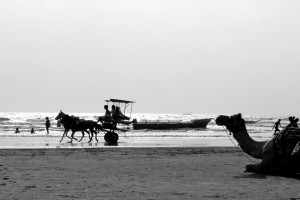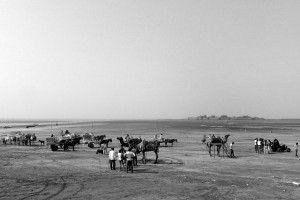 MUMBAI—The Arabian Sea is a shimmering blue-tinged gold and the tall palms a fringed wall of green. In between are the sands of Alibaug’s beaches. You can imagine those beaches have changed little since British colonists saw them from the decks of tall ships bound for old Bombay, or Shivaji’s armies marched by few hundred years before. Alibaug is a getaway spot for locals fleeing the crush of Mumbai. There are scores of hotels and guest houses but it is far off the international tourist trail. It is relaxing, at least compared to the non-stop Mumbai hustle of 30 million people and all of their machines and animals. The air seems clean and it is fairly quiet. There are breezes and trees and open spaces to rest the eye upon. The city of Alibaug itself is unlovely, nor are the beaches the white sands of Waikiki. But they have what beaches require, sun, sand, and surf and are not trash receptacles like Chowpatty and Juhu Beach in Mumbai. All in all this is what I expected. What I did not expect is what a visually surreal place Alibaug can be.
MUMBAI—The Arabian Sea is a shimmering blue-tinged gold and the tall palms a fringed wall of green. In between are the sands of Alibaug’s beaches. You can imagine those beaches have changed little since British colonists saw them from the decks of tall ships bound for old Bombay, or Shivaji’s armies marched by few hundred years before. Alibaug is a getaway spot for locals fleeing the crush of Mumbai. There are scores of hotels and guest houses but it is far off the international tourist trail. It is relaxing, at least compared to the non-stop Mumbai hustle of 30 million people and all of their machines and animals. The air seems clean and it is fairly quiet. There are breezes and trees and open spaces to rest the eye upon. The city of Alibaug itself is unlovely, nor are the beaches the white sands of Waikiki. But they have what beaches require, sun, sand, and surf and are not trash receptacles like Chowpatty and Juhu Beach in Mumbai. All in all this is what I expected. What I did not expect is what a visually surreal place Alibaug can be.
You can drive to Alibaug from Mumbai — and an interesting drive it is — through industrial flat lands, small towns, and forested mountains teeming with monkeys. But the drive is long and since the point of Alibaug is to escape traffic, there is  a much more pleasant way to get there. Each morning ferries packed with holiday makers depart from the British built Gateway of India down in Colaba. The top deck at the stern is the place to be. The morning sun makes the Gateway, that massive arching monument to failed empire glow gold. Other colorful ferries rock gently at anchor. When it is full, the ferry pulls away in a cloud of diesel smoke but a little out to sea the forward motion and ocean wind clear the air. The boat is followed by flocks of gulls, swirling and swooping, coming almost close enough to touch and everyone shrieks back at them, throwing bits of breakfast to the birds as tiffins are opened and food passed around.
a much more pleasant way to get there. Each morning ferries packed with holiday makers depart from the British built Gateway of India down in Colaba. The top deck at the stern is the place to be. The morning sun makes the Gateway, that massive arching monument to failed empire glow gold. Other colorful ferries rock gently at anchor. When it is full, the ferry pulls away in a cloud of diesel smoke but a little out to sea the forward motion and ocean wind clear the air. The boat is followed by flocks of gulls, swirling and swooping, coming almost close enough to touch and everyone shrieks back at them, throwing bits of breakfast to the birds as tiffins are opened and food passed around.
The ride is a pleasant hour or so, and at the dock you take a large motor rickshaw for an additional 20 minutes, puttering along down country lanes overhung by trees. We had booked a small guesthouse, taking one of the two rooms in a village outside the city. It became a lovely haven over the long weekend. The caretaker would ask us what we wanted to eat (the choices being prawns, fish, chicken, or vegetables). We would tell him and he would take off on his motorbike and come back with the fresh ingredients. He and his wife would cook them into delicious fresh meals while our older son played with the village kids and the older women came to take turns holding the baby, giving my wife a well needed rest.
The ferry left Bombay about 8:30 in the morning, and we found our guesthouse, ordered lunch, changed, hailed a rickshaw and were at a nearby beac h by 11 a.m. To the left and right were open, empty sands but for a few hundred yards in the middle was a vision of Indian beach weirdness. Brightly colored carts, streaming with flags, galloped through the surf pulled by tiny horses while the riders took selfies. Several entrepreneurs were giving camel rides and those ships of the desert were silhouetted against the sparkling waves of the midday ocean. Farther out were the canopies of parasailers and 20 foot inflatable tubes were pulled back and forth by motorboats while screaming families clung to their sides. In the middles of all this people were laying out, playing in the sand, swimming, eating snacks, playing soccer and cricket, and most of the women were dressed in bright red and orange and green and gold saris while they waded in the surf. It all melded into the weird cinematic vision of a Subcontinental Fellini. Like many scenes in India, I saw it in monochrome. There is always a tension here, as a photographer, between the vibrant color of India and the strong light, the shapes, shadows and silhouettes that translate so well in black and white.
h by 11 a.m. To the left and right were open, empty sands but for a few hundred yards in the middle was a vision of Indian beach weirdness. Brightly colored carts, streaming with flags, galloped through the surf pulled by tiny horses while the riders took selfies. Several entrepreneurs were giving camel rides and those ships of the desert were silhouetted against the sparkling waves of the midday ocean. Farther out were the canopies of parasailers and 20 foot inflatable tubes were pulled back and forth by motorboats while screaming families clung to their sides. In the middles of all this people were laying out, playing in the sand, swimming, eating snacks, playing soccer and cricket, and most of the women were dressed in bright red and orange and green and gold saris while they waded in the surf. It all melded into the weird cinematic vision of a Subcontinental Fellini. Like many scenes in India, I saw it in monochrome. There is always a tension here, as a photographer, between the vibrant color of India and the strong light, the shapes, shadows and silhouettes that translate so well in black and white.
The next day brought more strangeness. We took a motor rickshaw the other direction, to the town of Alibaug. The state of Maharashtra is littered with forts. They are everywhere, atop hill and mountain, dominating passes and approaches, commanding islands and bays. Alibaug, or Kolaba fort as it is alternately known, lies offshore about a mile at high tide. At low tied it is easily accessed by walking across tidal flats which are utterly bare save for the wave sculpted ripples of the sand. If you d on’t feel like walking, there are more camels and pony carts which will race across the sand, carrying you out to the old fort. These conveyances are silhouetted against the flat landscape and the sea is a dazzling mirage of light in the background. The fort itself is interesting. There is an Archeological Survey of India office on site and digging into the fort’s past is ongoing. Many of the layers of history are there to see without a shovel: a Hindu temple still in use, the refuse of partiers, some of which will add to the historical record, and several large British canons, cast in Sheffield. It was the tidal flats, however, that held my attention. Something of the landscape and the people crossing it had the appearance of a pilgrimage. The landscape was ocean and desert and tropical at once and each image, whether photographed or kept in memory, seemed to hold some coded memory, some element of archetype and myth.
on’t feel like walking, there are more camels and pony carts which will race across the sand, carrying you out to the old fort. These conveyances are silhouetted against the flat landscape and the sea is a dazzling mirage of light in the background. The fort itself is interesting. There is an Archeological Survey of India office on site and digging into the fort’s past is ongoing. Many of the layers of history are there to see without a shovel: a Hindu temple still in use, the refuse of partiers, some of which will add to the historical record, and several large British canons, cast in Sheffield. It was the tidal flats, however, that held my attention. Something of the landscape and the people crossing it had the appearance of a pilgrimage. The landscape was ocean and desert and tropical at once and each image, whether photographed or kept in memory, seemed to hold some coded memory, some element of archetype and myth.
 Alibaug is not a glamorous destination. It is a local beach town, a quick getaway from one of the world’s largest cities. Cheap, friendly, and basic, it serves well its stated purpose. But it occupies a larger psychic space and seems much farther away than it is. In the daily grind of Mumbai traffic, car horns, yells, streets jammed with busses, trucks, motor rickshaws, the stink of diesel, humans, animals and life, Alibaug is a place of sunlight and open space with the outlines of palms and camels etched on a glittering backdrop of the Arabian Sea.
Alibaug is not a glamorous destination. It is a local beach town, a quick getaway from one of the world’s largest cities. Cheap, friendly, and basic, it serves well its stated purpose. But it occupies a larger psychic space and seems much farther away than it is. In the daily grind of Mumbai traffic, car horns, yells, streets jammed with busses, trucks, motor rickshaws, the stink of diesel, humans, animals and life, Alibaug is a place of sunlight and open space with the outlines of palms and camels etched on a glittering backdrop of the Arabian Sea.
Post a Comment